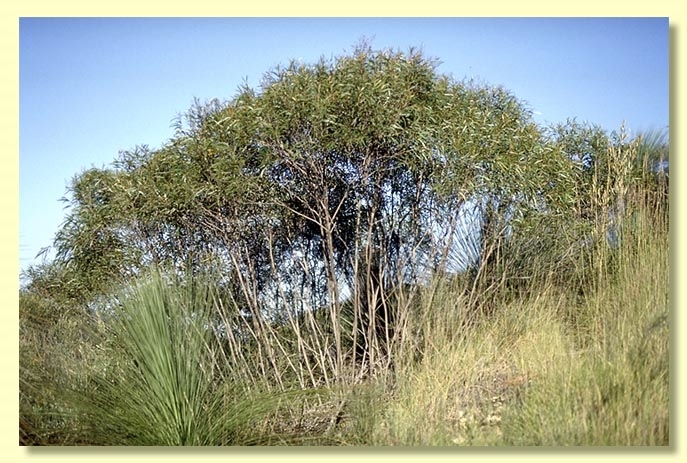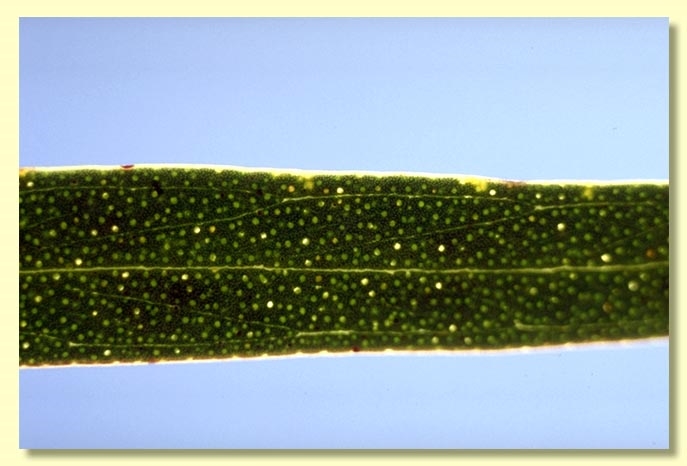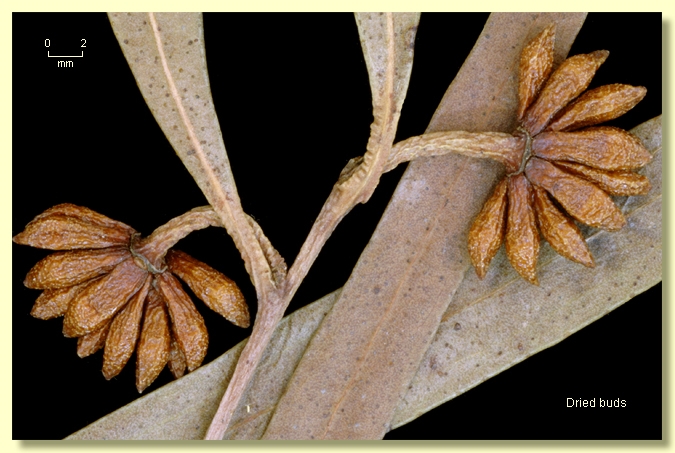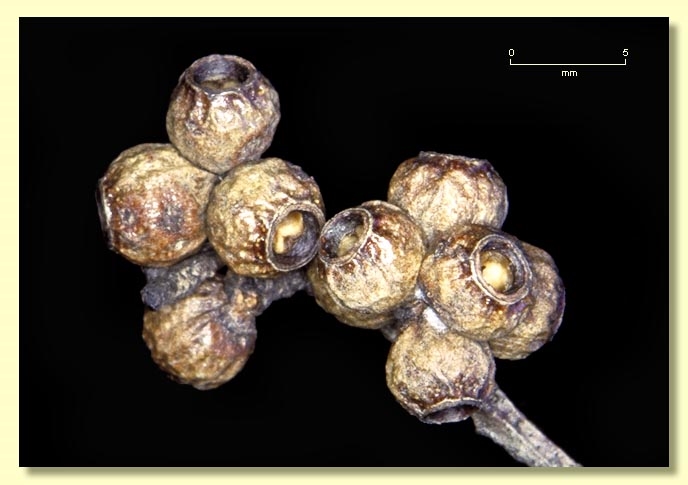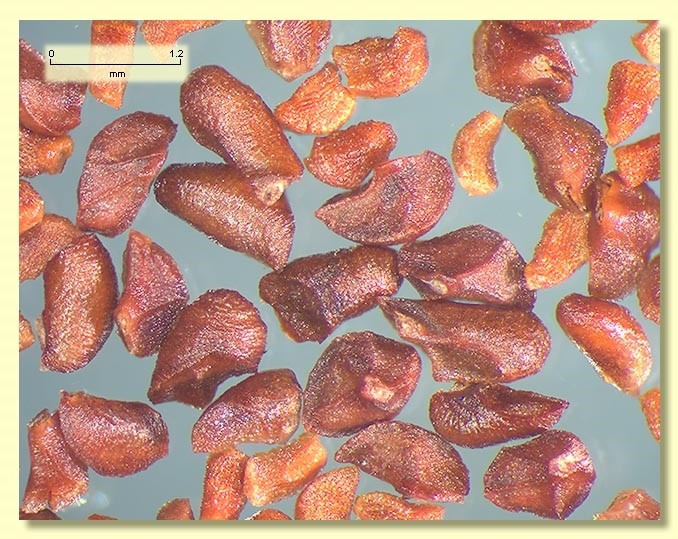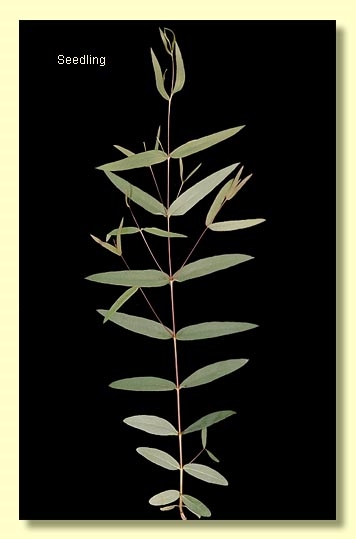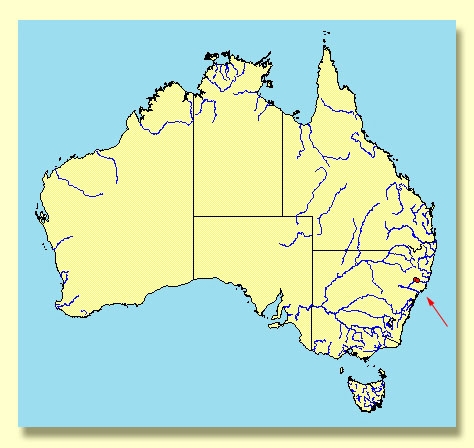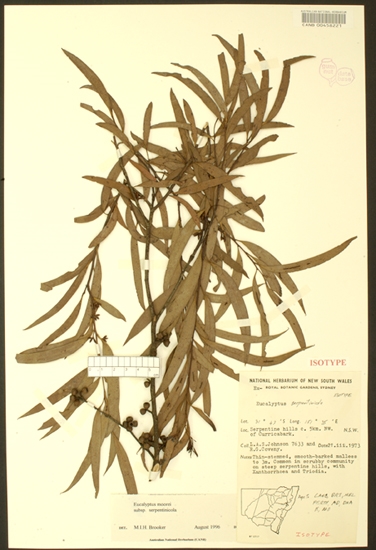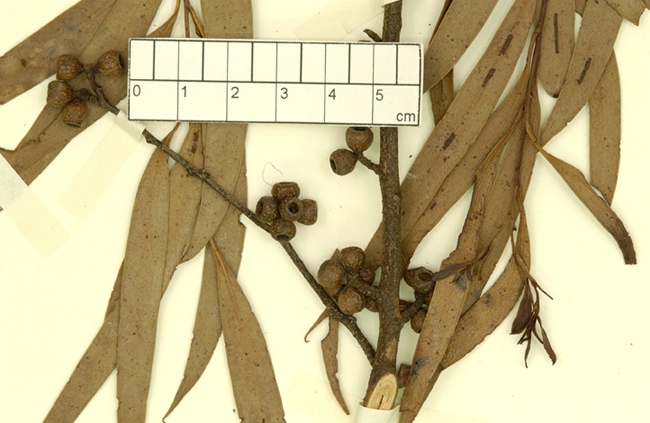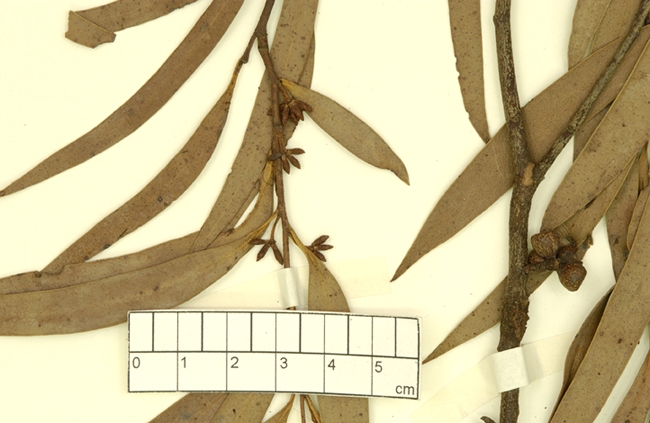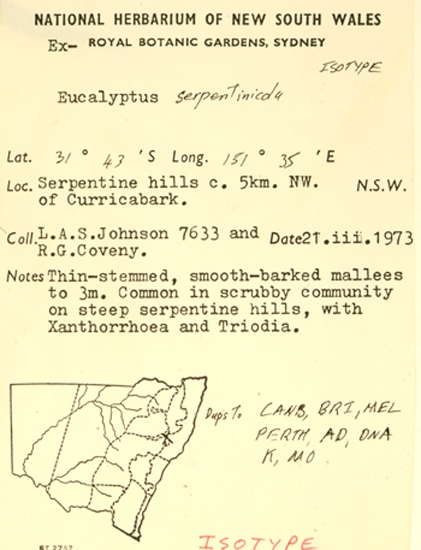Euclid - Online edition
Eucalyptus moorei subsp. serpentinicola
Eucalyptus | Eucalyptus | Longitudinales
Eucalyptus serpentinicola L.A.S.Johnson & Blaxell, Telopea 4: 262 (1991). T: NSW, North Coast, Serpentine Hills c. 5 km NW of Curricabark, 21 Mar. 1973, L.A.S.Johnson 7633 & R.Coveny; holo: NSW; iso: BRI, CANB, MEL, K.
Bark smooth, grey-brown to pale coppery with patches of orange and yellow.
Juvenile growth (coppice or field seedlings to 50 cm): stem round in cross-section; juvenile leaves opposite and sessile for some nodes then alternate, sessile to shortly petiolate, linear, 3–7 cm long, 0.2–0.7 cm wide, base tapering, apex finely pointed, green.
Adult leaves alternate, petiole 0–0.6 cm long; blade usually linear, 5–11 cm long, 0.3–1 cm wide, base tapering to petiole, concolorous, glossy, green, venation consisting of midrib and two more or less parallel veins plus a faint intramarginal vein, no reticulation, oil glands numerous, island.
Inflorescence axillary unbranched, peduncles 0.5–1 cm long, buds 9 to ?15 per umbel, arranged in stellate clusters, sessile or on pedicels only 0.1 cm long. Mature buds fusiform, 0.5 cm long, 0.2–0.3 cm wide, red to yellow or green, scar absent, operculum conical to horn-shaped, stamens irregularly flexed, anthers reniform to cordate, versatile, dorsifixed, dehiscing by confluent slits, style long, stigma blunt or tapered, locules 3, the placentae each with 2 vertical ovule rows. Flowers white.
Fruit sessile or on pedicels to 0.1 cm long, truncate-globose, 0.3–0.4 cm long, 0.4–0.6 cm wide, disc descending, valves 3, enclosed.
Seeds brown, 1–2 mm long, pyramidal or obliquely pyramidal, dorsal surface smooth, hilum terminal.
Cultivated seedlings (measured at ca node 10): not grown yet.
Flowering has been recorded in September and October.
Eucalyptus moorei is a mallee species occurring in several high mountain localities in New South Wales, preferring sites with coarse gritty sandy soils near to but slightly above swamps or boggy areas. Eucalyptus moorei is one of a small group of related species with small fusiform buds in axillary stellate clusters, differing by the habit, small size, completely smooth bark and narrower juvenile leaves from the widespread rough-butted sub-alpine tree or mallee E. stellulata, and differing from the Victorian endemic sub-alpine tree E. mitchelliana, which has smooth much whiter bark and longer juvenile and adult leaves. There are three other described taxa in the group, viz. the variety E. moorei var. latiuscula, E. moorei subsp. serpentinicola and the recently described E. dissita. We regard both var. latiuscula, with marginally broader juvenile leaves, and E. dissita from the eastern side of the Northern Tablelands of New South Wales with slightly longer petioles and scarcely shorter broader adult leaves, as part of E. moorei subsp. moorei because there is considerable overlap in dimensions.
There are two subspecies:
E. moorei subsp. moorei
Found in the Gibraltar Range, Blue Mountains, Budawang Range, Tinderry Range and in the Wadbilliga area, and recently found in the Ororral Valley ACT. It has elliptical to oblong juvenile leaves 0.6-2.5 cm wide, often growing on exposed sandstone sites near seepages.
E. moorei subsp. serpentinicola
It is found only in the Mooning Ground area north-west of Gloucester and is distinguished by its linear juvenile leaves 0.2–0.7 cm wide and highly unusual habitat, viz. isolated hills of red soil over serpentinite, where it grows with Triodia and Xanthorrhoea.
Eucalyptus moorei belongs in Eucalyptus subgenus Eucalyptus section Longitudinales because of the following combination of characters: mallee habit, juvenile leaves opposite for several to many pairs, adult leaves with side-veins more or less parallel to midrib, single axillary inflorescences, buds sessile and fusiform in stellate clusters, with buds having only one operculum, reniform anthers and ovules in two rows, and more or less pyramidal seeds. There are only three recognized species in section Longitudinales, E. stellulata, E. mitchelliana and E. moorei (with two subspecies), differing as outlined above.
Note about Eucalyptus copulans L.A.S.Johnson & K.D.Hill. This species was described in Telopea 4: 261 (1991) from three specimens collected in 1899, 1951 and 1957 from a creek on sandstone near Wentworth, in the Blue Mountains of New South Wales. At the time of publication it was thought to be extinct. Since then two plants have been rediscovered. The species seems to the authors of EUCLID to be very similar to E. moorei subsp. moorei but perhaps grows taller than that subspecies. The only differences between the original description of E. copulans, and the description of E. moorei subsp. moorei, as presented here in EUCLID, are the upper limit on length of juvenile leaves (slightly longer in E. copulans but largely overlapping) and the upper limit on widths of adult leaves (slightly wider in E. copulans but largely overlapping). Because of its morphological similarity we feel its taxonomic status needs to be re-assessed, and we have omitted it from EUCLID.
subsp. serpentinicola: Latin serpentinicola, dwelling on serpentine rock.

